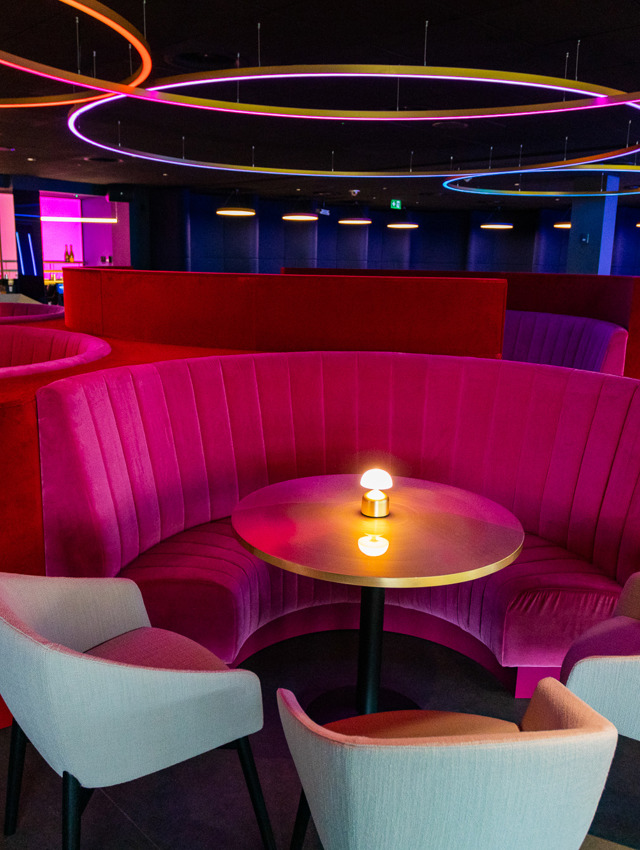
Balancing Privacy and Interaction in Booth Seating Design
Booth seating, a versatile and increasingly popular interior design concept, redefines the way people experience communal spaces across diverse settings.
In this blog, we'll reveal the secrets behind creating environments that empower individuals to connect, collaborate, and cherish moments of seclusion through thoughtful, well-planned booth seating design.
Consisting of enclosed or semi-enclosed seating arrangements, booth seating provides a blend of comfort, privacy, and social interaction. From bustling restaurants and cafes to modern office environments and welcoming waiting areas, booth seating offers fresh aesthetics and multipurpose functionality.
This style of seating not only maximises the use of space but also caters to our need to retreat and to connect with others. As individuals seek environments that speak to their need for interaction as well as moments of solitude, booth seating can be the best design solution, creating spaces that harmonise privacy and engagement.
Crafting comfortable and interactive spaces is important, as these environments profoundly impact human well-being and social dynamics. Comfortable spaces, through ergonomic design and thoughtful selection of materials, can give off a sense of physical ease and relaxation, promoting stress reduction and overall contentment.
At the same time, interactive spaces facilitate meaningful connections and engagement between people, giving rise to open communication, collaboration, and a strong sense of community. In both professional and social contexts, such spaces encourage the exchange of ideas, fostering creativity and innovation.
Striking the right balance between comfort and interactivity is essential to nurturing positive experiences, enhancing relationships, and cultivating environments where individuals can thrive both personally and professionally.
The role of privacy and Interaction in Booth Seating
Privacy takes on a multifaceted role in booth seating design, weaving psychological comfort and personal agency into the fabric of communal spaces. The integration of privacy elements, such as high-backed seats, partition walls, and adjustable dividers, will give a sense of refuge within a shared environment.
This sense of privacy empowers individuals to focus, engage in private conversations, or immerse themselves in tasks without the distractions of a bustling setting. Office booth seating can be particularly beneficial in a busy workplace. So too for busy eateries, where booth seating for restaurants can provide diners with an intimate backdrop for conversations, transforming a meal into a close, personal experience.
Privacy can help fight sensory overload, too. This is an increasingly prevalent concern in today's hyperconnected world. When used correctly, booth seating design can minimise visual and auditory distractions, fostering an environment conducive to concentration and relaxation.
Again, this is particularly relevant in workplace settings, where employees seek moments of isolation to concentrate on tasks, participate in confidential discussions, or even rejuvenate during short breaks, and in restaurant booth seating too.
As a result, privacy elements in booth seating design serve as a vital tool for enhancing well-being, productivity, and the overall quality of interactions, thereby contributing to the holistic experience of the space.
Booth seating design considerations
Balancing privacy and interaction in booth seating design presents a set of challenges that require careful consideration and innovative solutions.
1. Conflicting User Preferences
Individuals have varying preferences for privacy and interaction. Some may seek solitude, while others thrive in social environments. Designing a booth seating layout that caters to both ends of the spectrum can be demanding.
2. Spatial Constraints
The available physical space often dictates the degree to which privacy and interaction can be balanced. Striking the right balance while adhering to space limitations requires creative design solutions such as booth seating.
3. Aesthetics vs. Functionality
While maximising interaction might involve open and inviting layouts, maintaining privacy might necessitate enclosing structures. Achieving an aesthetically pleasing design that doesn't compromise either element can be a challenge.
4. Noise Considerations
Ensuring privacy often involves managing noise levels. Designing for acoustic insulation to prevent conversations from being overheard while allowing for comfortable interactions can be achieved with booth seating.
5. Flexibility
Spaces need to be adaptable to accommodate different scenarios, from intimate conversations to group discussions. Designing booths that can transition seamlessly between these modes while retaining their functionality can be complex.
6. Maintenance and Cleanliness
Booth seating designs with elements like high-backed chairs or partitions can present challenges in terms of cleanliness and maintenance, particularly in busy public spaces. This is why fabric selection is vital, so don't forget to consider this when choosing your booth seating.
Case Studies: Successful Privacy-Interaction Integration
The below case studies showcase Craftwood's booth seating designs. Each of these enables both intimate dinners and social gatherings, highlighting flexible work booths that foster collaboration and concentration, as well as waiting room seating that respects personal space while encouraging interaction.
Restaurant Booth Seating
Office Booth Seating
Waiting Area Booth Seating
Conclusion
The goal of booth seating design lies not in prioritising privacy with interactivity, but in crafting an environment where both can exist at the same time. Getting this right hinges on a thoughtful integration of elements that suit a range of people and scenarios, so through a user-centred approach to booth seating design, furniture makers like Craftwood can help tackle all of these challenges at the same time.
Flexibility is a key principle, and our adaptable designs can seamlessly transform secluded areas into hives of activity, giving people the autonomy to shape their spatial experiences.
If you want to explore booth seating for your space, contact Craftwood for a no-obligation consultation.